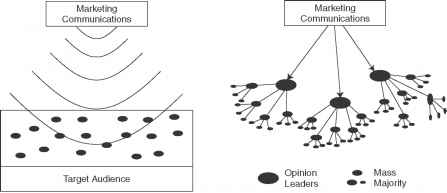The truth about opinion leaders
Simply by finding and reaching those few special people who hold so much social power, we can shape the course of social epidemics . . . Look at the world around you . . . With the slightest push - in the right place - it can be tipped . . . (Malcolm Gladwell, The Tipping Point).4
With the possible exception of Tom Peters's Thriving on Chaos,5 The Tipping Point by Malcolm Gladwell is perhaps the most influential and widely read book to date on the power of word of mouth. Voted by Forbes as one of the most influential business books of the past two decades, this international bestseller uses the science of social epidemics (runaway word of mouth) to outline a simple three-point formula for how word of mouth hits happen: 'the Law of the Few', 'the Stickiness Factor' and 'the Power of Context'. While the Stickiness Factor and the Power of Context deal with the 'what' and the 'where' of word of mouth (having something intrinsically worth talking about, in an environment conducive to word of mouth spread), the Law of the Few addresses the 'who', reminding us that the opinions of 10% of any target market will drive the buying behaviour of the other 90%.
Although Gladwell uses the language and jargon of epidemiology to unpack the concept of opinion leadership, the idea behind the Law of the Few is an established business truth dating back to the 1940s. Indeed, evidence for the Law of the Few was first produced in a 1940 landmark study on media influence conducted by Columbia University.6 The research found, contrary to what might be expected, that mass-media messages do not directly influence the mass market but instead influence a small minority of individuals who then influence their peers through word of mouth. The researchers coined a new term for these hubs of word of mouth mediating mass-media messages - 'opinion leaders' - proposing a new 'two-step flow' model of media influence to replace the discredited 'magic bullet' or 'hypodermic needle' model of direct media influence.
Since the discovery of opinion leaders, research across just about every product and service category has found that the opinions of an opinion-leading 10% do indeed tend to shape the opinions and purchases of the opinion-following 90%.7 Opinion leaders, simply defined as target buyers who frequently offer or are elicited for category-related advice by their peers, can include high-profile industry experts, journalists, reviewers and media celebrities. However, the vast majority of opinion leaders in any target market are simply regular clients, customers, or consumers, except for the fact that they have a peculiar 'connected and respected' profile - they are highly connected hubs of word of mouth in their social networks with opinions that are respected by their peers.
MYTH 'Magic Bullet' Model of Marketing Influence
REALITY 'Two-Step Flow' Model of Marketing Influence
MYTH 'Magic Bullet' Model of Marketing Influence
REALITY 'Two-Step Flow' Model of Marketing Influence

- Figure 1.1 Models of media influence
Thus, the influence of opinion leaders derives not from media appearances but from what sociometricians call 'network centrality' - they are word of mouth hubs, who connect everybody to everybody by six degrees of separation, and in doing so connect businesses to their target markets.
Because of the importance of opinion leaders in driving sales, a good deal of time has been invested in (a) finding ways to identify them and (b) among marketing agencies at least, re-branding them with some proprietary label ('Alphas', 'Hubs', 'Connectors', 'Influentials'(SM), 'Sneezers', etc.). While some subtle differences may lie behind the proprietary spin and various trademarked labels, it is worth remembering that the scientifically validated and peer-reviewed scales for identifying this group are called opinion leadership scales - precisely because they screen for opinion leadership (i.e. likelihood of this group's offering or having elicited from them, category-related advice).8
What we know about opinion leaders, apart from their connected and respected profile, is that opinion leadership tends to be category-specific - opinion leaders in off-road quad-bikes may or may not be opinion leaders in cosmetic beauty products. We also know that key correlates of opinion leadership are 'category involvement' (interest, knowledge and activity) and 'strength of personality' (persuasiveness and personal charisma). These correlates have enabled reliable opinion leadership scales to be developed and validated in order to be used by businesses for screening existing and target buyers.
Continue reading here: How to drive brand advocacy
Was this article helpful?
Readers' Questions
-
reginard lightfoot1 year ago
- Reply